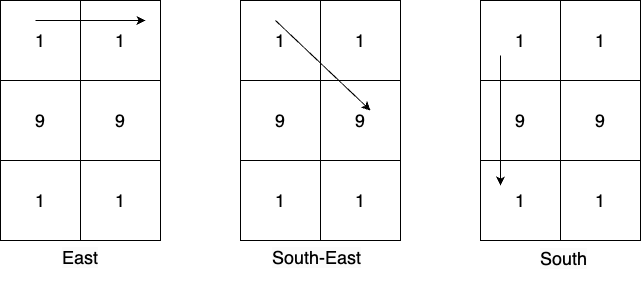Description
You are given a m x n 0-indexed 2D matrix mat. From every cell, you can create numbers in the following way:
- There could be at most
8paths from the cells namely: east, south-east, south, south-west, west, north-west, north, and north-east. - Select a path from them and append digits in this path to the number being formed by traveling in this direction.
- Note that numbers are generated at every step, for example, if the digits along the path are
1, 9, 1, then there will be three numbers generated along the way:1, 19, 191.
Return the most frequent prime number greater than 10 out of all the numbers created by traversing the matrix or -1 if no such prime number exists. If there are multiple prime numbers with the highest frequency, then return the largest among them.
Note: It is invalid to change the direction during the move.
Example 1:

Input: mat = [[1,1],[9,9],[1,1]] Output: 19 Explanation: From cell (0,0) there are 3 possible directions and the numbers greater than 10 which can be created in those directions are: East: [11], South-East: [19], South: [19,191]. Numbers greater than 10 created from the cell (0,1) in all possible directions are: [19,191,19,11]. Numbers greater than 10 created from the cell (1,0) in all possible directions are: [99,91,91,91,91]. Numbers greater than 10 created from the cell (1,1) in all possible directions are: [91,91,99,91,91]. Numbers greater than 10 created from the cell (2,0) in all possible directions are: [11,19,191,19]. Numbers greater than 10 created from the cell (2,1) in all possible directions are: [11,19,19,191]. The most frequent prime number among all the created numbers is 19.
Example 2:
Input: mat = [[7]] Output: -1 Explanation: The only number which can be formed is 7. It is a prime number however it is not greater than 10, so return -1.
Example 3:
Input: mat = [[9,7,8],[4,6,5],[2,8,6]] Output: 97 Explanation: Numbers greater than 10 created from the cell (0,0) in all possible directions are: [97,978,96,966,94,942]. Numbers greater than 10 created from the cell (0,1) in all possible directions are: [78,75,76,768,74,79]. Numbers greater than 10 created from the cell (0,2) in all possible directions are: [85,856,86,862,87,879]. Numbers greater than 10 created from the cell (1,0) in all possible directions are: [46,465,48,42,49,47]. Numbers greater than 10 created from the cell (1,1) in all possible directions are: [65,66,68,62,64,69,67,68]. Numbers greater than 10 created from the cell (1,2) in all possible directions are: [56,58,56,564,57,58]. Numbers greater than 10 created from the cell (2,0) in all possible directions are: [28,286,24,249,26,268]. Numbers greater than 10 created from the cell (2,1) in all possible directions are: [86,82,84,86,867,85]. Numbers greater than 10 created from the cell (2,2) in all possible directions are: [68,682,66,669,65,658]. The most frequent prime number among all the created numbers is 97.
Constraints:
m == mat.lengthn == mat[i].length1 <= m, n <= 61 <= mat[i][j] <= 9
Solution
Python3
def sieve(limit):
is_prime = [True] * (limit + 1)
is_prime[0] = is_prime[1] = False
for number in range(2, limit + 1):
if is_prime[number]:
for multiple in range(number * number, limit + 1, number):
is_prime[multiple] = False
return is_prime
PRIMES = sieve(10 ** 7)
class Solution:
def mostFrequentPrime(self, mat: List[List[int]]) -> int:
rows, cols = len(mat), len(mat[0])
counter = Counter()
for i in range(rows):
for j in range(cols):
for di in range(-1, 2):
for dj in range(-1, 2):
if di == dj == 0: continue
num = 0
ci, cj = i, j
while 0 <= ci < rows and 0 <= cj < cols:
num = num * 10 + mat[ci][cj]
ci += di
cj += dj
if num > 10 and PRIMES[num]:
counter[num] += 1
if len(counter) == 0: return -1
maxFreq = max(counter.values())
res = -1
for k, v in counter.items():
if v == maxFreq:
res = max(res, k)
return res